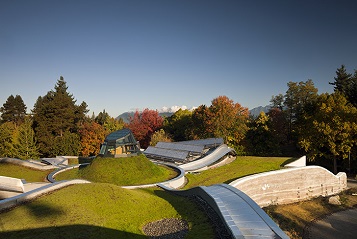Name: Amanda Sturgeon
Title: CEO
Organization: International Living Future Institute
Primary Responsibilities: “My primary responsibilities are to see us being successful in terms of our mission—creating a world filled with living buildings and living communities. My role is to grow the organization, scale our programs, and widen the reach of our programs. We are very innovative—pushing the edge to what may be possible—and pushing people farther than they think they can go.”

BAINBRIDGE ISLAND, WASH.—As CEO of the International Living Future Institute, Amanda Sturgeon oversees an organization that operates the Living Building Challenge, the built environment’s most rigorous performance standard, and Declare, an ingredients label for building materials. Within the International Living Future Institute is also the Cascadia Green Building Council and Ecotone Publishing. What Sturgeon is arguably most passionate about, however, is biophilic design—the practice of creating spaces that benefit both nature and humans. She is the founder and driving force behind the International Living Future Institute’s Biophilic Design Initiative and is a sought-after expert on biophilic design around the world.
Sturgeon recently released a new book entitled, “Creating Biophilic Buildings.” In the foreword, Judith Heerwagen, Affiliate Faculty, Department of Architecture, University of Washington, describes the book as “a thoughtful and enlightening look at how teams make decisions about deep biophilic design.” The book includes case studies—examples of projects that deal with biophilic design differently. “Nature as an organizing theme is apparent in all of the case studies,” Heerwagen adds. The case studies include a school, energy lab, botanical garden visitor center and other public structures.
“There weren’t case studies that showed clear strategies and what peoples’ lessons learned were,” Sturgeon says. “These 14 projects are not perfect but they show how biophilic design can make people healthier and happier.”
Living Building Standard a Challenge to Meet

No lodging establishments are included in the book. “We have not had any hotels step into our work,” Sturgeon told Green Lodging News. The Living Building Challenge standard is difficult to meet. It is more rigorous than LEED and comprises seven performance areas: site, water, energy, health, materials, equity and beauty. Living buildings produce net positive energy, water and waste—very difficult goals for most lodging establishments that operate 24 hours a day.
While constructing a “living building” is no easy task, Sturgeon says, “The potential of biophilic design to resonate is very powerful—bringing nature and light into a space.” Sturgeon says the lodging industry has the potential to play a greater role in promoting health and wellness and should utilize solar technology more. Hotel buildings should express their locations, she says, and consider the site’s positioning in relationship with the sun, wind and landscape.
“So many of the buildings we build in the developed world today have a disconnect with nature,” Sturgeon says. “We need to ask, ‘How can you dissolve the connection between inside and outside?’”
Raise Design Expectations
When asked whether architects and designers are being taught enough about biophilic design in colleges and universities, Sturgeon said, “I don’t think it is being taught well. We need to revisit how we train and equip architects and designers regarding how a building can be built specifically for a place. We are seeing too many cookie-cutter designs. Hotel owners should be asking more of their design teams.”
Does biophilic design cost more? “The real position of biophilic design is there is no extra impact,” Sturgeon says. “It does not cost more. There are simple things that biophilic design can bring in. Sometimes it is as simple as the choices of materials.”
Sturgeon’s interest in biophilic design grew while spending time in Australia and traveling through Asia. She studied architecture at the University of Sydney. She says she was very influenced by Australian vernacular architecture and entered architecture school intentionally looking for ways to reawaken the deep relationship between people and nature.
Glenn Hasek can be reached at editor@greenlodgingnews.com.






